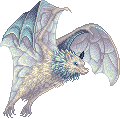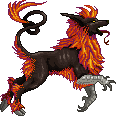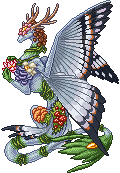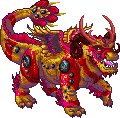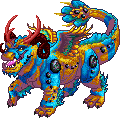This is to update the first post.
Bouba Baublebee


 General Description
General Description
Baublebees are large, colorful insects that appear around houses and other dwellings when the first snows come. They are shy, gentle creatures that mostly spend time hiding in any dark, warm places they can find, but once they become comfortable with the inhabitants of their winter home and are confident their delicate glass bodies won't be damaged, they'll start to come out into the open. At the peak of the winter season, they can be seen flying around a house and gathering in out-of-the-way spots like on potted plants, occasionally humming melodic tunes with their filigree wings.
Bouba baublebees have to grow fast because unlike honeybees, they live in very small communities of only a handful of individuals. Within a week or two, they are fully grown and ready to start collecting food to share with their nestmates. Like other bees, they drink nectar, and although they don't make much of it, they turn the nectar into honey which they store in small pots. During the summer, they're active pollinators of a wide variety of plants, using their long proboscises to access flowers of all shapes and sizes.
Baublebees are occasionally spotted in the warmer months as they wander from flower to flower, but they're often associated with the winter holidays as they retreat inside to avoid the cold. They are polite guests whose presence goes unnoticed for the first few weeks, but around the solstice, they might start to come out and spend a bit of time pollinating a person's houseplants. Their shimmering colors make them look like decorative ornaments come to life, and sometimes people will purposefully decorate their house with winter-blooming flowers to entice the bees out of their hiding spots. The bees don't really need nectar during the winter because they rely on their own hidden stores that they've accumulated over the summer. They like to winter inside of houses because of their warmth, and the nectar they collect while in a person's house is mainly used to create a special tiny honey pot which they leave behind as a thanks once the weather outside becomes more amenable. The winter honey of baublebees is extremely potent, and is usually mixed with other honeys to add to their flavor. Bouba baublebees have honey that tastes somewhat like ginger.


 General Description
General Description
Baublebees are large, colorful insects that appear around houses and other dwellings when the first snows come. They are shy, gentle creatures that mostly spend time hiding in any dark, warm places they can find, but once they become comfortable with the inhabitants of their winter home and are confident their delicate glass bodies won't be damaged, they'll start to come out into the open. At the peak of the winter season, they can be seen flying around a house and gathering in out-of-the-way spots like on potted plants, occasionally humming melodic tunes with their filigree wings.
Azraq baublebees have to grow fast because unlike honeybees, they live in very small communities of only a handful of individuals. Within a week or two, they are fully grown and ready to start collecting food to share with their nestmates. Like other bees, they drink nectar, and although they don't make much of it, they turn the nectar into honey which they store in small pots. During the summer, they're active pollinators of a wide variety of plants, using their long proboscises to access flowers of all shapes and sizes.
Baublebees are occasionally spotted in the warmer months as they wander from flower to flower, but they're often associated with the winter holidays as they retreat inside to avoid the cold. They are polite guests whose presence goes unnoticed for the first few weeks, but around the solstice, they might start to come out and spend a bit of time pollinating a person's houseplants. Their shimmering colors make them look like decorative ornaments come to life, and sometimes people will purposefully decorate their house with winter-blooming flowers to entice the bees out of their hiding spots. The bees don't really need nectar during the winter because they rely on their own hidden stores that they've accumulated over the summer. They like to winter inside of houses because of their warmth, and the nectar they collect while in a person's house is mainly used to create a special tiny honey pot which they leave behind as a thanks once the weather outside becomes more amenable. The winter honey of baublebees is extremely potent, and is usually mixed with other honeys to add to their flavor. Azraq baublebees have honey that tastes somewhat like mint and cinnamon.


 General Description
General Description
Baublebees are large, colorful insects that appear around houses and other dwellings when the first snows come. They are shy, gentle creatures that mostly spend time hiding in any dark, warm places they can find, but once they become comfortable with the inhabitants of their winter home and are confident their delicate glass bodies won't be damaged, they'll start to come out into the open. At the peak of the winter season, they can be seen flying around a house and gathering in out-of-the-way spots like on potted plants, occasionally humming melodic tunes with their filigree wings.
Firoza baublebees have to grow fast because unlike honeybees, they live in very small communities of only a handful of individuals. Within a week or two, they are fully grown and ready to start collecting food to share with their nestmates. Like other bees, they drink nectar, and although they don't make much of it, they turn the nectar into honey which they store in small pots. During the summer, they're active pollinators of a wide variety of plants, using their long proboscises to access flowers of all shapes and sizes.
Baublebees are occasionally spotted in the warmer months as they wander from flower to flower, but they're often associated with the winter holidays as they retreat inside to avoid the cold. They are polite guests whose presence goes unnoticed for the first few weeks, but around the solstice, they might start to come out and spend a bit of time pollinating a person's houseplants. Their shimmering colors make them look like decorative ornaments come to life, and sometimes people will purposefully decorate their house with winter-blooming flowers to entice the bees out of their hiding spots. The bees don't really need nectar during the winter because they rely on their own hidden stores that they've accumulated over the summer. They like to winter inside of houses because of their warmth, and the nectar they collect while in a person's house is mainly used to create a special tiny honey pot which they leave behind as a thanks once the weather outside becomes more amenable. The winter honey of baublebees is extremely potent, and is usually mixed with other honeys to add to their flavor. Firoza baublebees have honey that tastes somewhat like apples and nutmeg.


 General Description
General Description
Baublebees are large, colorful insects that appear around houses and other dwellings when the first snows come. They are shy, gentle creatures that mostly spend time hiding in any dark, warm places they can find, but once they become comfortable with the inhabitants of their winter home and are confident their delicate glass bodies won't be damaged, they'll start to come out into the open. At the peak of the winter season, they can be seen flying around a house and gathering in out-of-the-way spots like on potted plants, occasionally humming melodic tunes with their filigree wings.
Nila baublebees have to grow fast because unlike honeybees, they live in very small communities of only a handful of individuals. Within a week or two, they are fully grown and ready to start collecting food to share with their nestmates. Like other bees, they drink nectar, and although they don't make much of it, they turn the nectar into honey which they store in small pots. During the summer, they're active pollinators of a wide variety of plants, using their long proboscises to access flowers of all shapes and sizes.
Baublebees are occasionally spotted in the warmer months as they wander from flower to flower, but they're often associated with the winter holidays as they retreat inside to avoid the cold. They are polite guests whose presence goes unnoticed for the first few weeks, but around the solstice, they might start to come out and spend a bit of time pollinating a person's houseplants. Their shimmering colors make them look like decorative ornaments come to life, and sometimes people will purposefully decorate their house with winter-blooming flowers to entice the bees out of their hiding spots. The bees don't really need nectar during the winter because they rely on their own hidden stores that they've accumulated over the summer. They like to winter inside of houses because of their warmth, and the nectar they collect while in a person's house is mainly used to create a special tiny honey pot which they leave behind as a thanks once the weather outside becomes more amenable. The winter honey of baublebees is extremely potent, and is usually mixed with other honeys to add to their flavor. Nila baublebees have honey that tastes somewhat like cloves.


 General Description
General Description
Baublebees are large, colorful insects that appear around houses and other dwellings when the first snows come. They are shy, gentle creatures that mostly spend time hiding in any dark, warm places they can find, but once they become comfortable with the inhabitants of their winter home and are confident their delicate glass bodies won't be damaged, they'll start to come out into the open. At the peak of the winter season, they can be seen flying around a house and gathering in out-of-the-way spots like on potted plants, occasionally humming melodic tunes with their filigree wings.
Aurean baublebees have to grow fast because unlike honeybees, they live in very small communities of only a handful of individuals. Within a week or two, they are fully grown and ready to start collecting food to share with their nestmates. Like other bees, they drink nectar, and although they don't make much of it, they turn the nectar into honey which they store in small pots. During the summer, they're active pollinators of a wide variety of plants, using their long proboscises to access flowers of all shapes and sizes.
Baublebees are occasionally spotted in the warmer months as they wander from flower to flower, but they're often associated with the winter holidays as they retreat inside to avoid the cold. They are polite guests whose presence goes unnoticed for the first few weeks, but around the solstice, they might start to come out and spend a bit of time pollinating a person's houseplants. Their shimmering colors make them look like decorative ornaments come to life, and sometimes people will purposefully decorate their house with winter-blooming flowers to entice the bees out of their hiding spots. The bees don't really need nectar during the winter because they rely on their own hidden stores that they've accumulated over the summer. They like to winter inside of houses because of their warmth, and the nectar they collect while in a person's house is mainly used to create a special tiny honey pot which they leave behind as a thanks once the weather outside becomes more amenable. The winter honey of baublebees is extremely potent, and is usually mixed with other honeys to add to their flavor. Aurean baublebees have honey that tastes somewhat like lemon and chocolate.


 General Description
General Description
Baublebees are large, colorful insects that appear around houses and other dwellings when the first snows come. They are shy, gentle creatures that mostly spend time hiding in any dark, warm places they can find, but once they become comfortable with the inhabitants of their winter home and are confident their delicate glass bodies won't be damaged, they'll start to come out into the open. At the peak of the winter season, they can be seen flying around a house and gathering in out-of-the-way spots like on potted plants, occasionally humming melodic tunes with their filigree wings.
Royal baublebees have to grow fast because unlike honeybees, they live in very small communities of only a handful of individuals. Within a week or two, they are fully grown and ready to start collecting food to share with their nestmates. Like other bees, they drink nectar, and although they don't make much of it, they turn the nectar into honey which they store in small pots. During the summer, they're active pollinators of a wide variety of plants, using their long proboscises to access flowers of all shapes and sizes.
Baublebees are occasionally spotted in the warmer months as they wander from flower to flower, but they're often associated with the winter holidays as they retreat inside to avoid the cold. They are polite guests whose presence goes unnoticed for the first few weeks, but around the solstice, they might start to come out and spend a bit of time pollinating a person's houseplants. Their shimmering colors make them look like decorative ornaments come to life, and sometimes people will purposefully decorate their house with winter-blooming flowers to entice the bees out of their hiding spots. The bees don't really need nectar during the winter because they rely on their own hidden stores that they've accumulated over the summer. They like to winter inside of houses because of their warmth, and the nectar they collect while in a person's house is mainly used to create a special tiny honey pot which they leave behind as a thanks once the weather outside becomes more amenable. The winter honey of baublebees is extremely potent, and is usually mixed with other honeys to add to their flavor. Royal baublebees have honey that tastes somewhat like grapes.

This bright egg has sweet chirps coming from within it, but touching it makes your fingers sting.
General Description
Wallatrice are named for their call, a drawn-out 'waa-laa, waa-laa' most often heard during the crisp autumn nights when they're most active. This noise is quite high and almost sweet, which means magi are often surprised to follow it and meet its large, brightly-coloured, aggressive owner. Wallatrice will fight just about anything, aided by their venomous spines and their ability to sweat poison down their legs to coat their sharp talons. Females are duller than their male counterparts to help aid in the protection of their nests, but as both parents are highly involved with their hatchlings, predators usually spot the male's bright colours and know to find easier, less poisonous prey.


Male / Female
Hatchling Description
Wallatrice hatchlings react to most noise and movement by crouching, hissing, and biting anything that comes within range. Even newly hatched they are venomous, but fortunately this poison isn't nearly as strong as that of the adults. Hatchlings enjoy playing with each other, which looks quite rough from the outside, but their hard feathers keep them from serious harm and their parents are always nearby to break up any real fights.
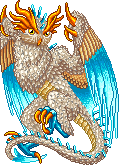

Male / Female
Adult Description
Adult wallatrice are wonderful parents and terrible to any other creature that dares to approach them. If raised from an egg by a patient magi, they will see that magi as part of their family, but that doesn't mean they won't hand out a good nip or swat with their powerful wings if offended. When not actively raising a family, wallatrice adults like to groom each other, lurk in high shadowy areas to startle people walking by, and eat sweet berries until something needs fighting.

This bright egg has sweet chirps coming from within it, but touching it makes your fingers sting.
General Description
Wallatrice are named for their call, a drawn-out 'waa-laa, waa-laa' most often heard during the crisp autumn nights when they're most active. This noise is quite high and almost sweet, which means magi are often surprised to follow it and meet its large, brightly-coloured, aggressive owner. Wallatrice will fight just about anything, aided by their venomous spines and their ability to sweat poison down their legs to coat their sharp talons. Females are duller than their male counterparts to help aid in the protection of their nests, but as both parents are highly involved with their hatchlings, predators usually spot the male's bright colours and know to find easier, less poisonous prey.


Male / Female
Hatchling Description
Wallatrice hatchlings react to most noise and movement by crouching, hissing, and biting anything that comes within range. Even newly hatched they are venomous, but fortunately this poison isn't nearly as strong as that of the adults. Hatchlings enjoy playing with each other, which looks quite rough from the outside, but their hard feathers keep them from serious harm and their parents are always nearby to break up any real fights.
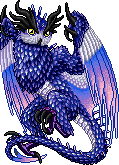
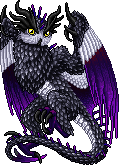
Male / Female
Adult Description
Adult wallatrice are wonderful parents and terrible to any other creature that dares to approach them. If raised from an egg by a patient magi, they will see that magi as part of their family, but that doesn't mean they won't hand out a good nip or swat with their powerful wings if offended. When not actively raising a family, wallatrice adults like to groom each other, lurk in high shadowy areas to startle people walking by, and eat sweet berries until something needs fighting.
The badge for gifting 10 different people.












